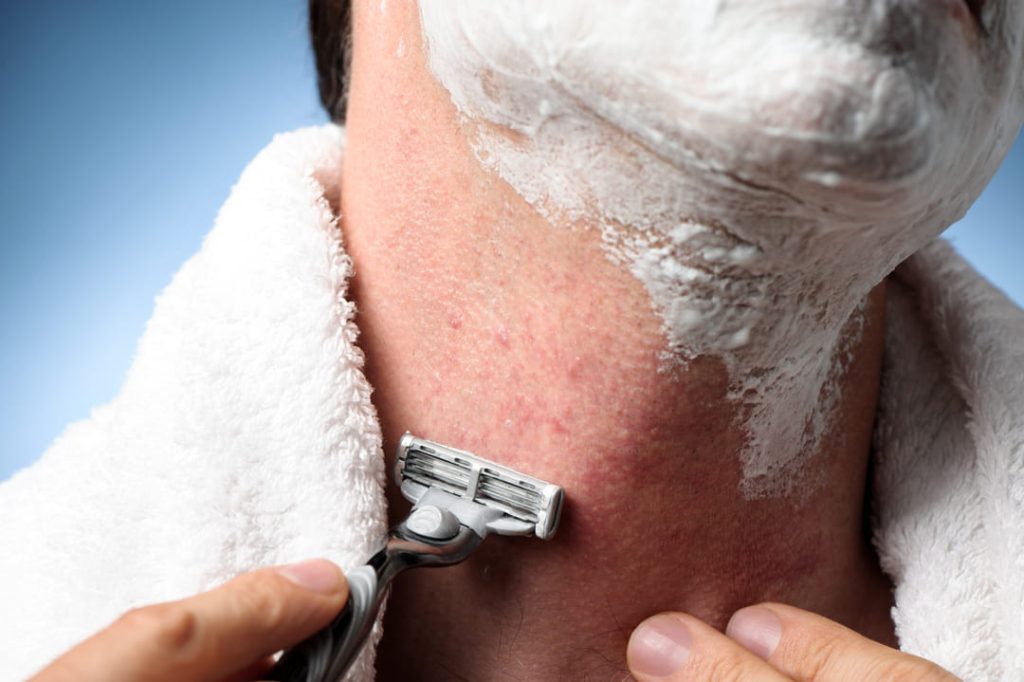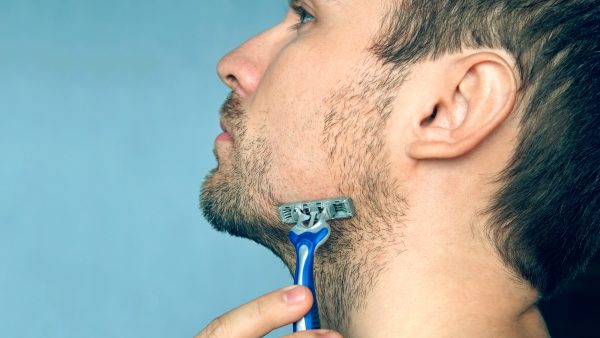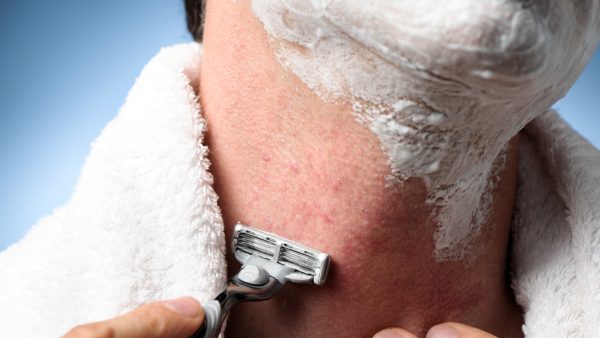Looking for Expert-Level VA Claim Answers?📱Call Us Now! 737-295-2226
Veterans, if you’re struggling with Pseudofolliculitis Barbae (PFB) and seeking a VA rating for your condition, you’re in the right place.
Managing PFB has been a challenge for veterans for a long time. Also called razor bumps or ingrown hair, pseudofolliculitis barbae has a long history in the military. Dating back to World War I, shaving was enforced to ensure good personal hygiene and that gas masks would seal in the event of a chemical attack.
In this article, we’ll share five steps to help you win a pseudofolliculitis barbae VA rating, including information on what qualifies and what you need to win your VA claim.
Table of Contents
Summary of Key Points
- Pseudofolliculitis Barbae (PFB) (also known as razor bumps or ingrown hairs) is a chronic skin condition that often results from daily military shaving requirements.
- To win a VA rating, you need three things: a medical diagnosis, proof of an in-service event (like shaving requirements), and a nexus linking your PFB to service.
- The VA rates PFB under Diagnostic Code 7806 (skin conditions) or Diagnostic Code 7800 (scars), with ratings from 0% to 60%, depending on severity and treatment.
- If denied, veterans can file a Higher-Level Review, Supplemental Claim, or appeal to the Board of Veterans’ Appeals.

Step 1: Understanding PFB
What is PFB?
PFB stands for Pseudofolliculitis Barbae. It’s a skin condition that occurs when hair that has been shaved, plucked, or waxed grows back into the skin, causing inflammation, bumps, and sometimes infection.
PFB is common among people with curly or coarse hair, and it typically affects the beard area in men. Still, it can also affect other body parts where hair is removed.
If you’ve ever had ingrown hairs or razor bumps, you may suffer from PFB.
When hair is cut, it often has a sharp edge that can pierce the skin as it grows back, causing inflammation and irritation. The hair then grows into the skin instead of up and out of the hair follicle, leading to bumps and sometimes infection.
PFB can also occur in areas other than the beard, such as the neck, chest, legs, and pubic area, or wherever hair is removed. The condition can be chronic and impact veterans for years, even after they leave service and no longer shave daily.
-
Related: VA Disability for Skin Conditions
What causes Pseudofolliculitis Barbae?
PFB is primarily caused by hair growth and hair removal methods. However, several other factors can contribute to its development. Some of the conditions that can cause or worsen PFB include:
- Curly or coarse hair that grows in a tight curl or wave
- Shaving too closely or with a dull razor
- Using improper shaving techniques or tools
- Wearing tight clothing or equipment that rubs against the skin
- Having oily skin or using heavy, greasy products
- Hormonal imbalances, such as polycystic ovary syndrome (PCOS)
- Certain medications, such as steroids or testosterone replacement therapy
- Skin conditions like atopic dermatitis or eczema, which can lead to skin irritation and inflammation
- Superficial scars that can cause the hair to grow at an improper angle
- Acne or other skin conditions can cause inflammation and irritation of the hair follicles
- Ingrown hair cysts or other follicular disorders
- Bacterial or fungal infections of the hair follicles
- Allergic reactions to hair removal products or other topical agents
Identifying the underlying cause of PFB to treat the condition and prevent further complications is key to getting the treatment you deserve.
Pseudofolliculitis Barbae in Veterans
Veterans are at an increased risk of developing PFB due to the nature of their work and the grooming requirements of the military. Shaving every day can lead to frequent irritation and inflammation of your hair follicles.
In addition to the daily grooming requirements, you may be exposed to harsh chemicals and other irritants that most civilians don’t encounter.
Step 2: Learn the Requirements to Get a Pseudofolliculitis Barbae VA Rating
To get a VA rating for pseudofolliculitis barbae, aka a shaving profile VA rating, you need to meet three requirements:
- You have a medical diagnosis of pseudofolliculitis barbae
- You have an in-service event or injury that led to you developing pseudofolliculitis barbae or worsening as a result of your service
- You have a link, or nexus, between your service and your PFB diagnosis (service connection)
In general, showing in your Service Treatment Records that you began dealing with PFB while in service will help you prove service connection. However, you may have another service-connected condition that led to your development of PFB, enabling you to win your VA rating for pseudofolliculitis barbae.
Step 3: Make Sure You Can Get Service Connected for Pseudofolliculitis Barbae
To be eligible for a pseudofolliculitis barbae VA rating, you must establish service connection. There are three ways to do this: direct service connection, secondary service connection, and presumptive service connection.
Direct Service Connection
Direct service connection is the most common way to establish service connection for PFB. This means that the condition was incurred or aggravated during your military service.
To prove direct service connection, you must provide evidence linking the onset or aggravation of PFB to your military service. This may include medical records, service records, and other evidence that show you developed PFB while serving in the military.
Even if you don’t have a diagnosis of PFB in your service treatment records, if you can show you were experiencing symptoms of PFB, this may be enough to prove direct service connection.
Secondary Service Connection
Secondary service connection means that the PFB results from a service-connected disability.
You must have a service-connected condition that caused your PFB. However, you can file for both conditions at the same time.
For example, if you have a service-connected disability that requires you to take medication that aggravates your PFB, you may be eligible for secondary service connection. To establish secondary service connection, you will need to provide medical evidence that links the service-connected disability to your pseudofolliculitis barbae in order to be awarded a VA rating.
Presumptive Service Connection
Presumptive service connection applies to certain medical conditions that are presumed to be related to your military service, even if there is no direct evidence linking the condition to your service.
PFB: A Gulf War Presumptive Condition
PFB is one condition that qualifies under the Gulf War presumptive conditions under the category of an undiagnosed illness or medically unexplained chronic multisystem illness. If you’ve had PFB for six months or more and served in the Gulf War, PFB qualifies as a “skin symptom.” You could be approved for a pseudofolliculitis barbae VA rating under presumptive service connection.
Step 4: Learn How the VA Rates Pseudofolliculitis Barbae
The VA uses two different methods to assign a pseudofolliculitis barbae VA rating.
Method 1: General Rating Formula for the Skin
Usually, razor bumps are classified under Diagnostic Code 7806 using the general rating formula for the skin. The general rating formula looks at how much of your skin is impacted by your condition.
Systemic therapy, as listed below, includes any of the following treatments: corticosteroids, phototherapy, retinoids, biologics, photochemotherapy, psoralen with long-wave ultraviolet-A light (PUVA), or other immunosuppressive drugs.
To qualify for a VA disability rating, you must meet at least one of the following criteria for each level to earn that rating:
- 60% VA rating for pseudofolliculitis barbae
- Characteristic lesions involving more than 40% of the entire body or more than 40% of exposed areas affected
- Constant or near-constant systemic therapy over the past 12-month period
- 30% VA rating for pseudofolliculitis barbae
- Characteristic lesions involving 20 to 40% of the entire body or 20 to 40% of exposed areas affected
- Systemic therapy required for a total duration of more than 6 weeks over the past 12-month period
- 10% VA rating for pseudofolliculitis barbae
- Characteristic lesions involving at least 5% but less than 20% of the entire body affected; or at least 5% but less than 20% of exposed areas affected
- Intermittent systemic therapy required for a total duration of less than 6 weeks over the past 12-month period.
- 0% VA rating for pseudofolliculitis barbae
- Characteristic lesions involving less than 5% of the entire body affected
- Characteristic lesions involving less than 5% of exposed areas affected, and no more than topical therapy required over the past 12-month period.
Most veterans will fall under the 30% category for pseudofolliculitis barbae and shaving bumps, impacting anywhere from 20%-40% of your exposed area (on your face, neck, and head).
Method 2: Scars
If you have scars on your head, face, or neck due to PFB, you may be eligible for a VA rating based on the pseudofolliculitis barbae VA rating code under Diagnostic Code 7800.
Here are the two VA ratings typically assigned if your PFB resulted in scarring:
- 30% VA rating for pseudofolliculitis barbae
- This rating is given if there is visible or palpable tissue loss and gross distortion or asymmetry of one feature or paired set of features. Examples of facial features include the nose, chin, forehead, eyes (including eyelids), ears (auricles), cheeks, and lips
- If you have two or three characteristics of disfigurement
- 10% VA rating for pseudofolliculitis barbae
- If you have one characteristic of disfigurement, you may be eligible for a 10 percent rating
Step 5: Prepare for your C&P Exam for Pseudofolliculitis Barbae
If you’re scheduled for a Compensation & Pension (C&P) exam for Pseudofolliculitis Barbae, you can expect a few things.
First, the examiner will review your medical records and ask you questions about your condition, including how it affects your daily life and work. They may also ask about any treatments you’ve tried and whether they were effective.
To help give you a pseudofolliculitis barbae VA rating, the VA will require that your claim include a Skin Diseases Disability Benefits Questionnaire (DBQ). This goes through your medical history, diagnosis, and treatment, and includes a section for a physical exam.
There’s a section for scars, and if your provider marks yes, they will also complete a Scars DBQ.
During the physical exam, the examiner will inspect the affected areas of your skin to evaluate the extent and severity of your condition. They may also check for scarring or any other visible signs of damage. Depending on your specific case, they may also take photographs or measurements to document the extent of your condition.
The information the VA gathers from this exam will influence the VA’s decision about your pseudofolliculitis barbae VA rating.
What to Do if the VA Denies You a Pseudofolliculitis Barbae VA Rating
If the VA denies you a pseudofolliculitis barbae VA rating, you have options to appeal the decision:
- File a Higher Level Review – your best option if you think the VA made a mistake and want a quick decision
- File a Supplemental Claim – if you have new evidence to submit, this may be the best option
- Appeal to the Board of Veterans’ Appeals – if you want to appeal directly to a judge and have your case reviewed with more latitude
A successful claim could help you get the compensation you deserve for your condition.
Remember, it’s common for the VA to deny claims at first. Don’t be discouraged; you have options to appeal and can seek support from VA Claims Insider.
Don’t let the fear of being denied hold you back from filing a pseudofolliculitis barbae VA claim. Your service deserves recognition, and you have the right to fight for the benefits you’ve earned.
NEED MORE ASSISTANCE?
Most veterans are underrated for their disabilities and, therefore, not getting their due compensation. At VA Claims Insider, we help you understand and take control of the claims process, so you can get the rating and compensation you’re owed by law.
Our process takes the guesswork out of filing a VA disability claim and supports you every step of the way in building a fully developed claim (FDC)!
If you’ve filed your VA disability claim and have been denied or have received a low rating—or you’re unsure how to get started—reach out to us! Take advantage of a VA Claim Discovery Call. Learn what you’ve been missing—so you can FINALLY get the disability rating and compensation YOU DESERVE!
FAQs
Can you get VA disability for razor bumps or ingrown hairs?
Yes. The VA recognizes pseudofolliculitis barbae (razor bumps) as a compensable condition. If your symptoms began in service or are linked to another service-connected condition, you may qualify for benefits.
How does the VA rate pseudofolliculitis barbae?
Most veterans are rated under Diagnostic Code 7806 for skin conditions. Ratings range from 0% to 60%, based on the percentage of skin affected and the type/length of treatment required. If scarring is present, ratings may also be assigned under Diagnostic Code 7800.
What evidence do I need to win a PFB VA claim?
Key evidence includes: a medical diagnosis, service treatment records showing shaving-related skin problems, a nexus opinion from a medical provider, and C&P exam results (including a Skin DBQ or Scars DBQ if applicable).
Is PFB a presumptive condition for Gulf War veterans?
Yes. Veterans who served in the Gulf War may qualify for presumptive service connection if they’ve had chronic PFB (six months or longer) as a “skin symptom” of an undiagnosed illness.
What happens if my VA claim for PFB is denied?
You can appeal in three ways: request a Higher-Level Review, file a Supplemental Claim with new evidence, or appeal to the Board of Veterans’ Appeals. Many veterans win on appeal after gathering stronger evidence.
Author

Trisha Penrod
Trisha Penrod is a former active-duty Air Force officer. As an Intelligence Officer, she led teams of analysts to apply advanced analytic skills to identify, assess, and report potential threats to U.S. forces.
Trisha attended the U.S. Air Force Academy and holds an MBA from Webster University. After receiving an honorable discharge in 2018, Trisha worked as a growth marketer and utilizes her analytic skills to help others accomplish their business goals.



